Tennessee Tech Archives recently received a relic from the past— IBM punch cards (Image 1). These paper-based, 7 3/8 by 3 ¼ inch cards were the primary means of programming computer instruction, performing data input, and storing data beginning in the late 19th century through to the mid- 20th century.
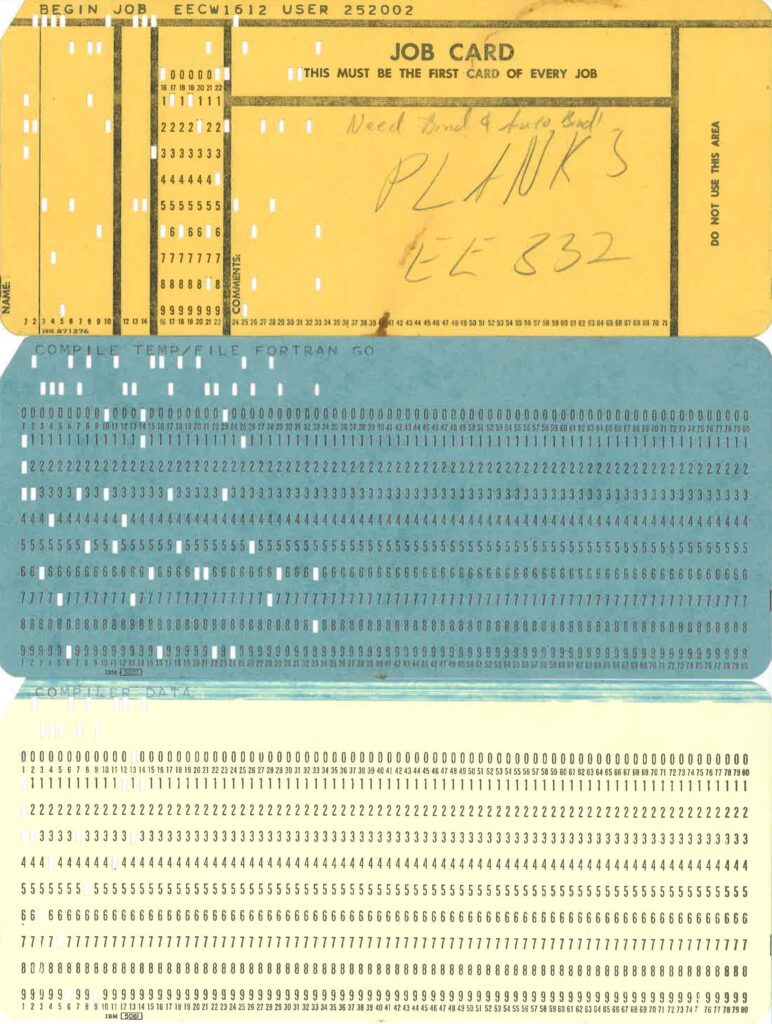
Punch cards originated in the 1880s when United States census clerk Herman Hollerith developed punch cards and the tabulating machine to assist the United States Census in 1890. Hollerith’s idea was grounded in the inventions of weaver and merchant Joseph Marie Jacquard, who used punch cards to automate steam-powered looms, and mathematician Charles Babbage, who designed a polynomial calculating machine using punch cards. Player pianos also used a type of punch card technology, where rolls of music with holes would indicate the note played on the piano, as did punched train tickets.
Hollerith’s invention enabled the government to complete the 1890 census in two years instead of the historic eight years using his innovations. The tabulating machine used mercury-lined pins, which traveled through the punch cards’ round holes to complete electrical circuits. Results registered on a counter board. Hollerith recognized the impact his invention had on saving time and money, and in 1896, turned his invention into a business, the Tabulating Machine Company. By 1911, the Tabulating Machine Company merged, and the resulting businesses eventually became International Business Machines, or IBM, in 1924.
With new and faster means to capture and store data, companies and businesses requested more data. IBM responded and revised its punch cards to include 80 columns that used rectangular holes instead of circular ones in 1928. Many punch cards came printed with what became a familiar phrase, “Do not spindle, fold, or mutilate.” IBM improved punch card technology again when it made punches “electrographic” or “Mark Sense,” allowing for pencil-marked cards to be changed into punch cards.
The first documented use of punch card-type technology on campus began in 1959 when the Department of Engineering purchased an analog computer for differential equations at a price of $5,000. In October 1959, Engineering Science built a new computer laboratory that included a desk calculating machine, an IBM 610 personal digital computer, and three electronic analog computers. The early computer laboratory was in Henderson Hall and shared its space with a subcritical reactor supplied with 5,500 pounds of nuclear fuel provided by the Atomic Energy Commission! Later, in 1963, punch card technology’s use expanded on campus enough that the University created positions for statistical services and IBM operator, which by 1966 became the IBM Tabulating and Statistical Services Department coordinated by J. Pate Pointer.
These new computer laboratories provided spaces to accommodate for Tennessee Tech University’s changing curriculum initiated by computers. By 1958, the University began offering computer classes in its Engineering Science Program including the “Principles of Digital Computers,” and “Digital Computer Laboratory,” a class that required students to program and code one math problem using the IBM 610, which used punched tape— a type of punch card technology. The punch cards seen here are a sample of punch cards being used to solve complex equations by engineering students. The information needed to be added correctly and the card order needed to be precise for the computer to work efficiently.
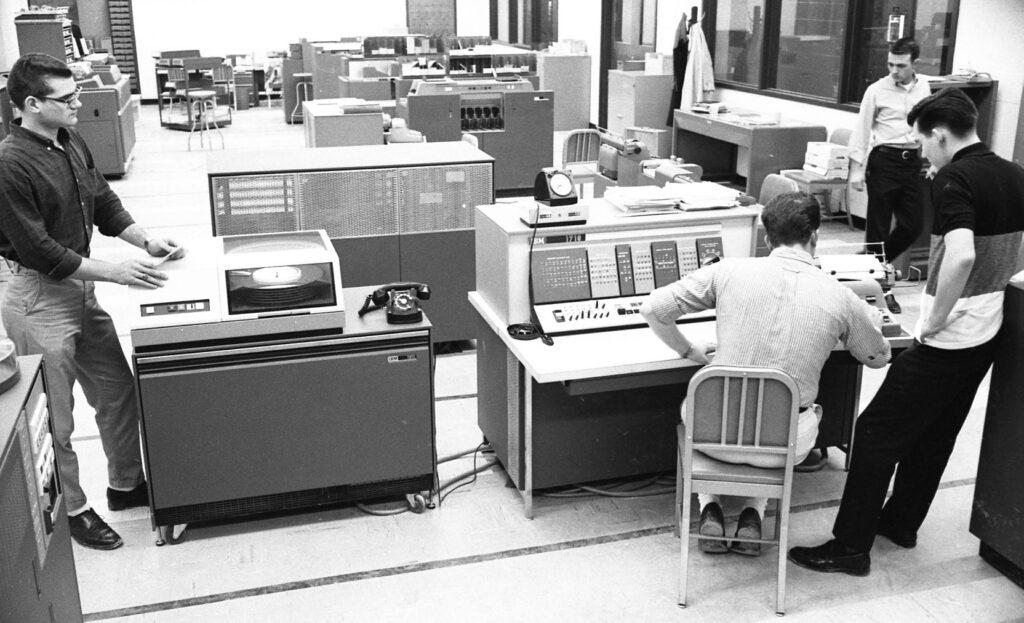
During the Christmas holiday of 1964, Tennessee Tech completed Clement Hall, the new engineering building. It provided space for the D.W. Mattson Computer Center, named after the Chair of Civil Engineering, who pushed for the facility. The computer center cost $350,000 and included two IBM 1620 digital computers, an IBM 1311 Disk File System, an IBM 1710, two keypunches, a collator, an alphabetic interpreter, a reproduction punch, and an auto plotter (Odom, 1). The IBM 1710 reportedly held two-million digits (0 or 1) of information. The lab assisted student education but was also for campus-wide activities such as grading, surveying, testing, payroll, automating alumni records, sectioning for registration, preparing housing reports, research, and data analysis. The Associated Student Body used punch cards in their 1964 elections; the ROTC designed a program to improve supply orders; and in 1965, the IBM 1710 was even used to pick dance partners for a school formal. The annual report for engineering in 1964 described the computer center and new computers as completing work faster than previously and making more complex data processing tasks possible.
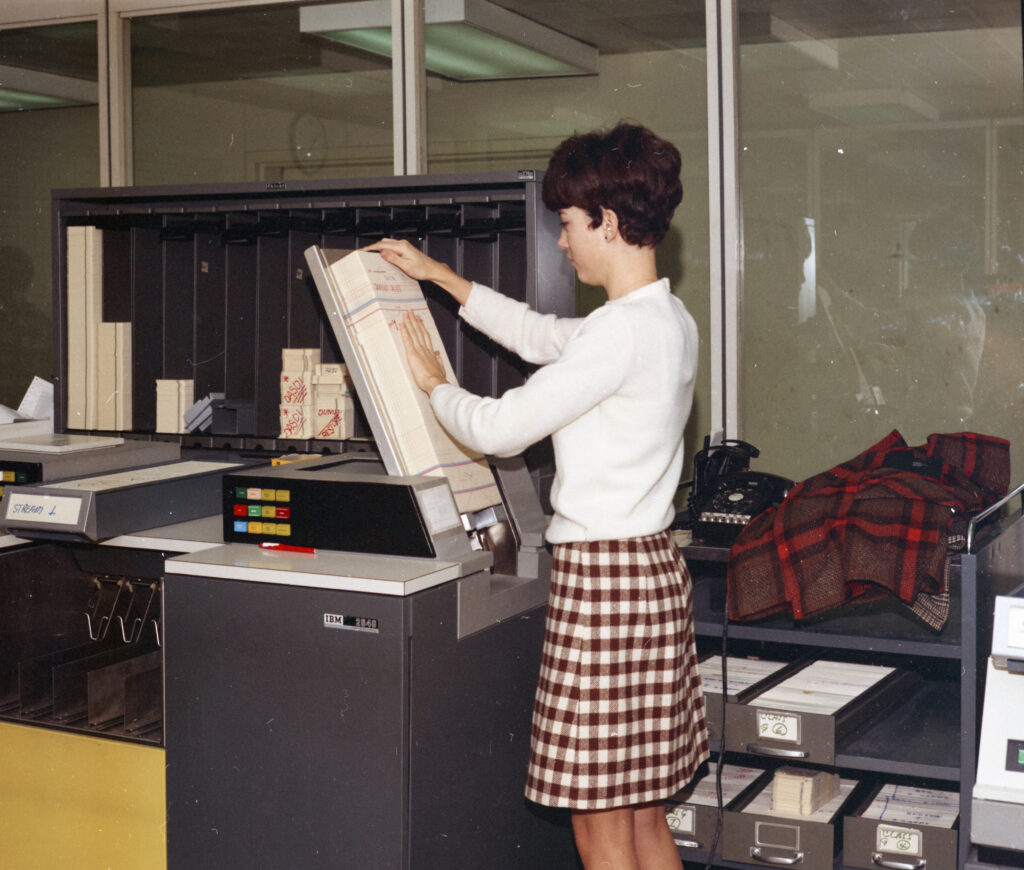
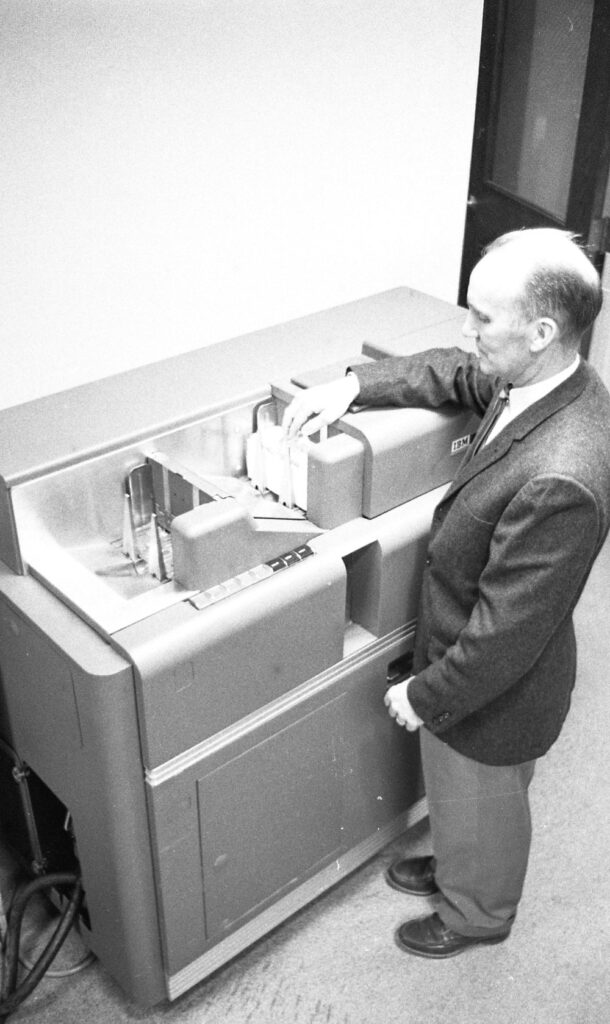
Also, in 1964, Tennessee Tech implemented the IBM punch card system for registration using computer sectioning. Prior to this, registration was done manually, but better automation was necessary to provide for the nationwide phenomenon of increased enrollment on college campuses due to social and political changes, such as the GI Bill or the Civil Rights Act of 1964. Registration took 30 minutes for most students that year, and 3,291 students registered using the method.
The IBM tagline, “Do not spindle, fold, or mutilate,” printed on most IBM cards, was a small issue in comparison to the many headaches punch cards created; however, the punch cards were still more efficient than previous methods. Overall, punch cards needed to be handled carefully. The order of the cards mattered when performing programs and required numerous cards. The “punches” also needed to be filled in appropriately. If incorrect, the user started again on a new card.
After using the IBM 1710 for registration in March of 1965, students spoke about the system saying, “If I had been more careful, I would have been able to complete registration within an hour,” and “…IBM registration is efficient and well worth the trouble.” Many students commended the computer, but others felt it was difficult and wanted it to have more capabilities. Early programming did not accommodate for exceptions, redundant data, scholarships, full classes, professor preferences, and overlapping times, amongst other things. Computer programs did what they were told to do and if a solution was needed for a distinct set of circumstances, it needed to be created (via punch card programming of course). One computer software did not necessarily run on another type of computer. Despite some issues with registration experienced by some students, the software completed the course cards in 30 hours.
Punch cards were on campus for many years following their early initiation. In 1987, Dr. Hoyle Lawson and Dr. Robert Craighead developed computer registration using an Optical Mark Reading System, an idea based on the University of Georgia’s system. At the time, Tennessee Tech’s punch card system was wearing out and the University required a new system.
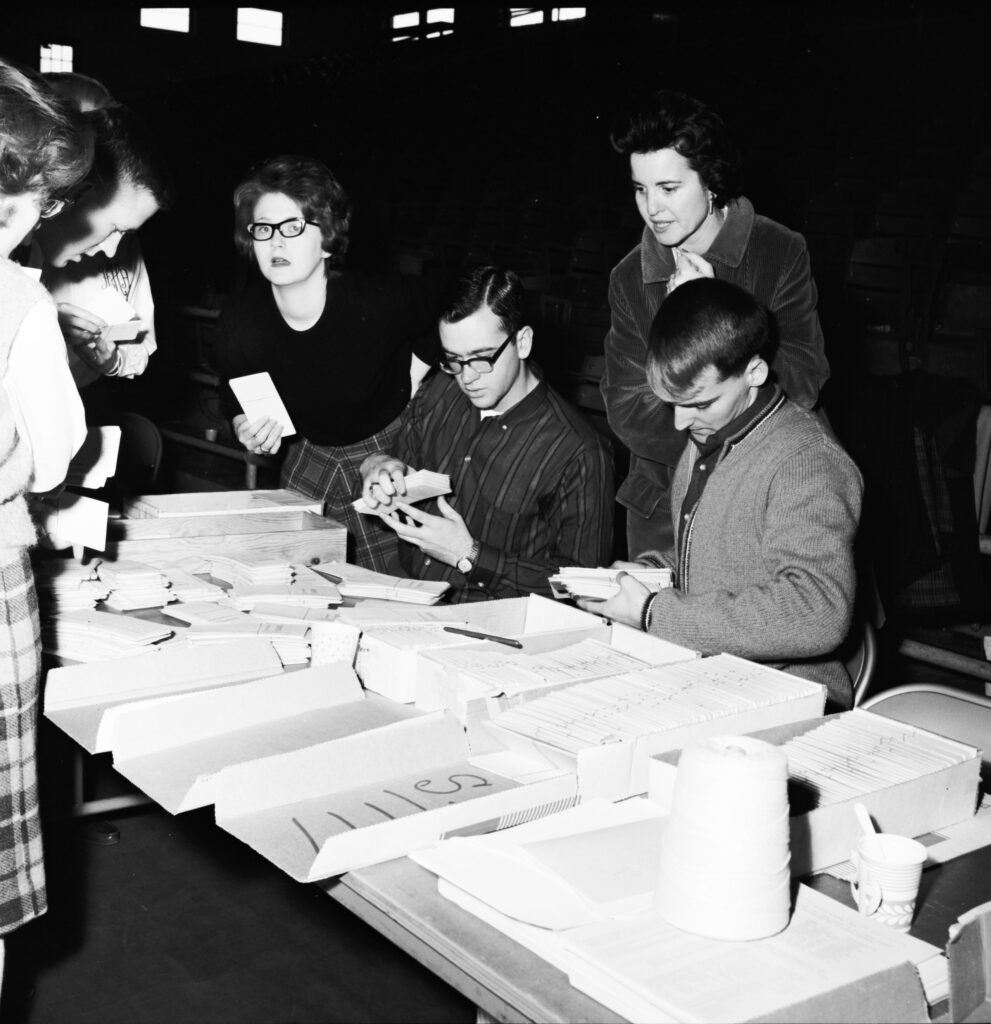
Tennessee Tech’s use of the punch cards system came at an opportune time in the university’s history. Tennesse Tech just changed its name from Tennessee Polytechnic Institute to Tennessee Technological University in 1965, emphasizing the future of the university’s technology and engineering programs. The computer and punch cards were part of the transition, leading Tennessee Technological University into the computer age. With punch cards and computers in place, campus employees devoted more time to tasks rather than data processing, were able to explore data using methods unattainable manually, had better control of their data, and could perform data tasks faster, and for less money.
Photographs showing punch card technology in use on campus
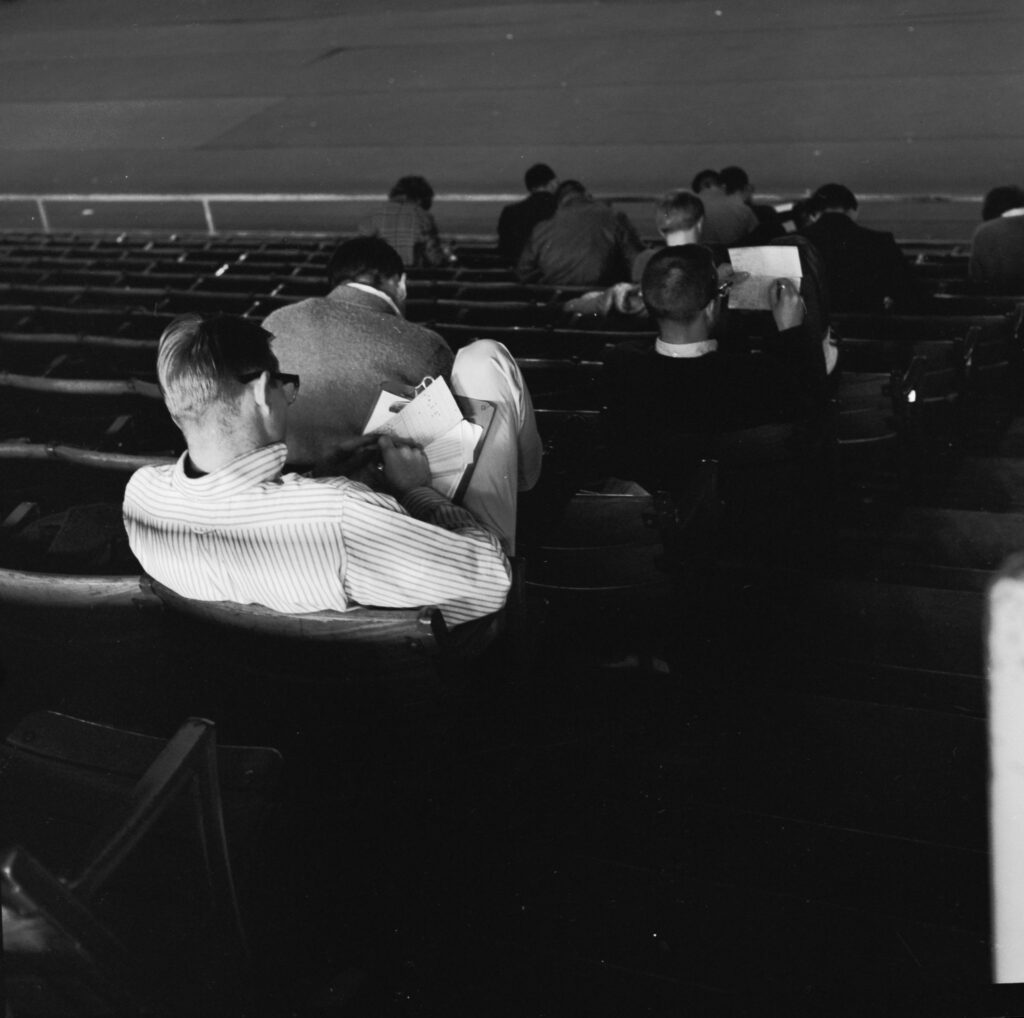
Photo Services, Engineering Labs, Box 48, Folder 44, April 1963. Accessed November 16, 2022. https://tntech.access.preservica.com/uncategorized/SO_f66fab4b-af0a-4f7d-8d5c-ec686dd749f3/
Photo Services, Nuclear Labs, Box 48, Folder 148, November 1962. Accessed November 16, 2022. https://tntech.access.preservica.com/uncategorized/SO_1a6152be-dd6f-41a3-a452-3898b6562760/
Photo Services, Registration (Spring), Box 105, Folder 44, 1964. Accessed November 16, 2022. https://tntech.access.preservica.com/uncategorized/SO_14fd238a-79a2-4ac7-887a-ebb6cc4c97ab/
Photo Services, Registration — Winter Quarter), Box 105, Folder 46, January 4, 1964. Accessed November 16, 2022. https://tntech.access.preservica.com/uncategorized/SO_d0c0d488-1e7a-48b3-a50b-9f42012de186/
Photo Services, Nuclear reactor lab, Box 48, Folder 134, October 14, 1965. Accessed November 16, 2022. https://tntech.access.preservica.com/uncategorized/SO_1e84bad3-46fb-41df-b4e7-1a3e1eb1a4eb/
Photo Services, Analog Computer Lab, Box 48, Folder 135, June 1965. Accessed November 16, 2022. https://tntech.access.preservica.com/uncategorized/IO_4bf4bca2-5bdb-47c5-bd9f-2118182f4252/
Photo Services, Computer lab, Box 48, Folder 139, February 9, 1965. Accessed November 16, 2022. https://tntech.access.preservica.com/uncategorized/SO_1abe72ea-2f1f-477d-bcfe-03580608918e/
Photo Services, Analog computer lab, Box 48, Folder 121, April 1966. Accessed November 16, 2022. https://tntech.access.preservica.com/uncategorized/SO_1ecb05d5-02fb-4b28-90b9-4d7e1bcf17c9/
Photo Services, Computer lab, Box 48, Folder 123, April 1966. Accessed November 16, 2022. https://tntech.access.preservica.com/uncategorized/SO_cae455af-c357-4eb0-8d02-611341f74bac/
Photo Services, Gary Rice working in Electrical Engineering lab, Box 48, Folder 123, September 19, 1967. Accessed November 16, 2022. https://tntech.access.preservica.com/uncategorized/SO_0fad11bd-69bc-4736-b746-c115f26ed1df/
Photo Services, Computer Lab-Card Punching Machine, Box 48, Folder 88, April 1968. Accessed November 16, 2022. https://tntech.access.preservica.com/uncategorized/SO_30c73f13-6961-459d-a716-8293b7aa2f51/
Photo Services, Registration, Box 105, Folder 25, September 18, 1969. Accessed November 16, 2022. https://tntech.access.preservica.com/uncategorized/SO_8afb63de-d38a-4063-9594-43d847f655d1/
Photo Services, Women Engineer majors working in Electrical Engineering Lab, Box 48, Folder 2, January 1, 1974. Accessed November 16, 2022. https://tntech.access.preservica.com/uncategorized/SO_3dd3a744-1d0e-42f6-84bb-d4679c1f13f7/
Photo Services, Systems Lab and Keypunch Computer (Engineering), Box 48, Folder 20, November 21, 1974. Accessed November 16, 2022. https://tntech.access.preservica.com/uncategorized/SO_365dd756-fd24-4775-9b57-ed6583a795cb/
Photo Services, Registration, Box 105, Folder 25, September 18, 1969. Accessed November 16, 2022. https://tntech.access.preservica.com/uncategorized/SO_8afb63de-d38a-4063-9594-43d847f655d1/
Photo Services, Registration — IBM — Spring, Box 105, Folder 45, 1964. Accessed November 16, 2022. https://tntech.access.preservica.com/uncategorized/SO_93be5db7-d496-40af-b889-c08865ebe0c4/
Resources and Further Readings
“Albert L. Duke,” The Oracle, Vol. 35 No. 13 April 11, 1958, Accessed November 15, 2022. https://tntech.access.preservica.com/uncategorized/IO_d1929030-7d44-4db5-9058-5019deea5d52/
Black, Edwin. 2012. IBM and the Holocaust: The Strategic Alliance between Nazi Germany and America’s most Powerful Corporation. 2nd ed. Highland Park, Michigan: Dialog Press.
The Bulletin, Tennessee Polytechnic Institute, 1958, Accessed November 17, 2022. https://tntech.access.preservica.com/uncategorized/IO_4533e1b4-8463-45bc-b2a8-4463282b8b90/
The Bulletin, 1959-1960, Tennessee Technological University. Accessed November 15, 2022. https://tntech.access.preservica.com/uncategorized/IO_5441dd55-6f65-44c3-8679-c0dda45968d0/
The Bulletin, Tennessee Technological University, 1966, Accessed November 15, 2022. https://tntech.access.preservica.com/uncategorized/IO_a2a596bc-85d9-444f-9687-3ed26d582187/
Carpenter, Ann. Computers to Arrange Schedules for Spring Quarter Registrants, The Oracle, Vol. 41, No. 9b, February 21, 1964. Accessed November 15, 2022. https://tntech.access.preservica.com/uncategorized/IO_9e4a4e97-568b-4347-b411-88c9561972f3/
Computer Punch Cards Historical Overview – IBM Remington Rand UNIVAC – History Archives, # CH-0093. Computer History Project, 2015. Accessed November 15, 2022. https://www.youtube.com/watch?v=kKJxzay85Vk
Data Processing: An Introduction. Directed by Peter D. Abrams. Computer History Project, 1972. Accessed November 15, 2022. Computer History 1964-1972: DATA PROCESSING An Introduction (IBM 360, Mag Tape, Punch Cards)
The Eagle yearbook, Tennessee Technological University, 1987, Accessed November 15, 2022. https://tntech.access.preservica.com/uncategorized/IO_31856ad4-cba3-4281-a711-eb20c257a95f/
Endsley, Lorraine. “Registration Aided with Computer, The Oracle, Vol. 41, No. 12. Accessed November 15, 2022. Accessed November 15, 2022, https://tntech.access.preservica.com/uncategorized/IO_2cff6833-4495-44b1-8d05-9af9dda5be22/
Engineering Annual Report 1964-1965, Tennessee Polytechnic Institute, Accessed November 17, 2022. https://tntech.access.preservica.com/uncategorized/IO_39706dba-9e5d-4180-bf67-94fda8f94c29/
French, Charles O. “How to Vote: IBM Cards used as Ballots,” The Oracle, Vol. 41, No. 13, April 10, 1964, Accessed November 17, 2022. https://tntech.access.preservica.com/uncategorized/IO_8dff427d-2d83-4288-b61a-de3f4e11a861/
Grover, Arland L. “A Study of the Development and use of Computer Class -Sectioning in Selected Universities to Determine the Implications and Feasibility of Implementing a Computer-Type Program for the University of Wyoming.” Order No. DP14878, University of Wyoming, 1967. https://ezproxy.tntech.edu/login?url=https://www.proquest.com/dissertations-theses/study-development-use-computer-class-sectioning/docview/302270391/se-2.
Heard, Serena. “Science, Engineering Get Emphasis,” The Oracle, Vol. 37, No. 1, October 2, 1959. Accessed November 15, 2022. https://tntech.access.preservica.com/uncategorized/IO_a4c1edfe-ea62-47e0-b17a-69b4b50f3c8f/
Huddleston, Christy. A Brief History and Chronology of the Tennessee Technological University College of Engineering, 1915-2011, Tennessee Technological University, 2011.
“The IBM Punched Card.” IBM’s 100 Icons of Progress., last modified February 25, 2011, accessed November 15, 2022. https://www.ibm.com/ibm/history/ibm100/us/en/icons/
Marshall, Pat. “The Students Speak: Registration Delays Seen Unavoidable; ‘renowned machine’ marked scapegoat,” The Oracle, Vol. 42 No. 2 October 9, 1964, Accessed November 15, 2022. https://tntech.access.preservica.com/uncategorized/IO_3f7f7bbe-d2f7-46c1-a321-d6a9549bd0d4/
Odom, Carolyn. “Departments, schools move,” The Oracle, Vol. 41, No.16, April 4, 1964. Accessed November 15, 2022. https://tntech.access.preservica.com/uncategorized/IO_324cb316-35b8-4b7a-a1c6-2bb4d5fb0f0f/
“The Punched Card Tabulator.” IBM’s 100 Icons of Progress., last modified July 12, 2011, accessed November 15, 2022. https://www.ibm.com/ibm/history/ibm100/us/en/icons/.
“Registration Line Draws Complaints,” The Oracle, Vol. 41 No. 7, January 10, 1964. Accessed November 15, 2022. https://tntech.access.preservica.com/uncategorized/IO_2cff6833-4495-44b1-8d05-9af9dda5be22/
Simmons, Robert. “Engineers give class in IBM programming,” The Oracle, Vol. 40 No. 9, February 8, 1963. Accessed on November 17, 2022. https://tntech.access.preservica.com/uncategorized/IO_b415202c-f2ac-4fae-a065-b136d2d7915e/
Thompson, Betsye. “Computer work done by Tech Students,” The Oracle, Vol. 42 No. 9b, February 12, 1965. https://tntech.access.preservica.com/uncategorized/IO_1d348723-2acc-45e5-9995-71d392b19a78/
